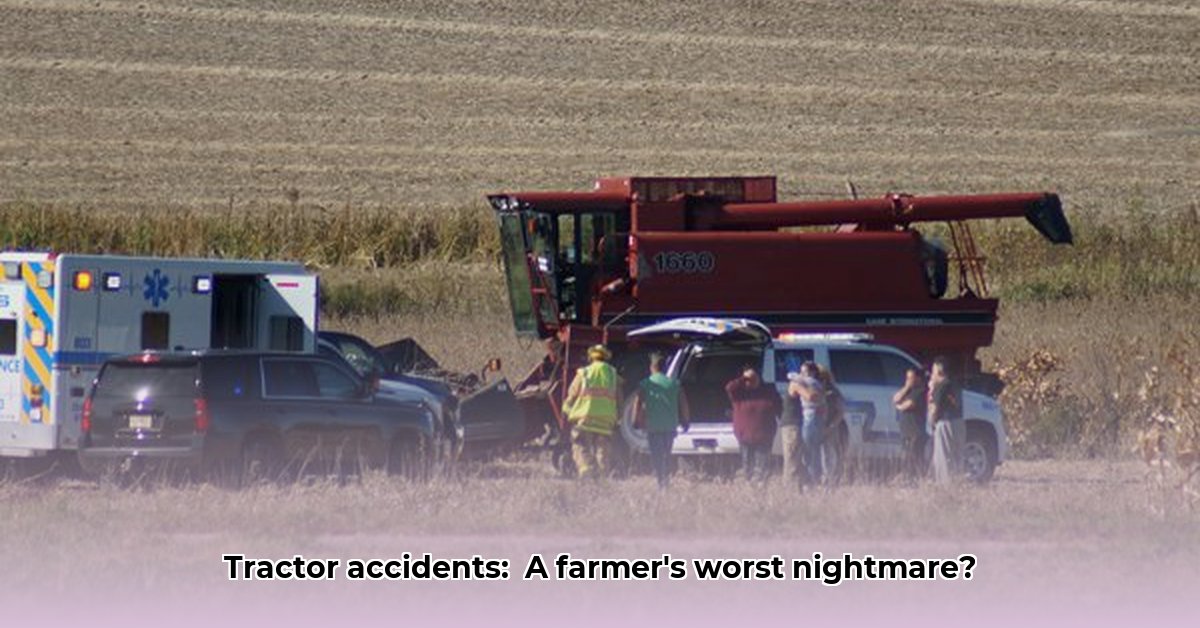
Farmer Died in Tractor Accident: A Preventable Tragedy
Every year, farming families across the nation endure the unimaginable loss of a loved one in a tractor accident. These aren't just statistics; they are devastating personal tragedies that ripple through communities. The death of a farmer is a profound loss, demanding immediate action and a steadfast commitment to change. This isn't simply about workplace safety; it's about preserving lives and strengthening rural communities. For more information on a recent tragedy, see this tragic accident.
The Stark Reality: A Crisis in Agriculture
The data is alarming. Agricultural fatalities significantly outpace those in almost any other profession, with tractor accidents being a leading cause. Reports of farmers dying in tractor accidents are far too common, highlighting a critical need for immediate and decisive action. This isn't merely a concern; it's a full-blown crisis demanding urgent attention. How can we, as a society, better protect those who feed us?
Understanding the Dangers: Why Accidents Happen
Fatal tractor accidents frequently involve rollovers. Tractors, unlike cars, are top-heavy, making them extremely vulnerable to tipping, particularly on uneven terrain or slopes. Mechanical failures compound the risk, with sudden brake failures or hydraulic line bursts leading to catastrophic consequences.
- Rollover Accidents: The leading cause of death, often due to the absence of rollover protection structures (ROPS) (protective frame designed to prevent tractor from rolling over onto the operator) or a lack of seatbelt use.
- Equipment Malfunctions: Faulty brakes, hydraulic system failures, or other mechanical problems significantly increase the risk. Regular maintenance and inspections are vital yet frequently overlooked.
- Human Error: Fatigue, distraction, inadequate training, or operating under the influence of alcohol or drugs contribute substantially to accidents.
- Environmental Factors: Adverse weather conditions (rain, snow, fog) can diminish visibility and traction, increasing the risk of rollovers and other accidents.
A Team Effort: Building a Safer Future for Farmers
Addressing this crisis requires a collaborative effort involving farmers, manufacturers, government agencies, and insurance providers. Each stakeholder plays a critical role in preventing these heartbreaking accidents.
For Farmers:
- Invest in Safety: Prioritize safety features like ROPS and seatbelts. These aren't luxuries; they're lifesavers.
- Regular Maintenance: Regularly inspect your equipment to prevent mechanical malfunctions. A well-maintained tractor is fundamentally a safer tractor.
- Invest in Training: Stay updated on safety protocols and best practices. Consider specialized safety courses.
- Prioritize Wellness: Never operate a tractor when tired, impaired, or experiencing health issues that could impact judgment.
- Adapt to Conditions: Exercise extreme caution in inclement weather. Reduce speeds and increase awareness.
For Manufacturers:
- Safety as Standard: Make safety features (like ROPS) standard equipment on all new tractors. Safety shouldn't be optional; it's non-negotiable.
- Affordable Upgrades: Offer affordable upgrade packages for older equipment, making safety improvements accessible to all farmers.
- Invest in Technology: Invest in R&D for advanced safety technologies (e.g., automated emergency braking systems).
For Government Agencies:
- Fund Safety Initiatives: Increase funding for farm safety education programs, research, and regulatory enforcement.
- Improved Data Collection: Systematically track agricultural accidents to identify emerging trends. Data-driven solutions are crucial.
- Stronger Regulations: Develop and enforce stricter safety standards and regulations.
For Insurance Companies:
- Incentivize Safety: Offer discounted premiums for farmers employing proven safety measures.
- Specialized Insurance: Develop specific insurance packages covering advanced safety technologies.
A Risk Assessment Matrix: Understanding the Probabilities
| Technology/Practice | Likelihood of Accident | Severity of Impact | Overall Risk | Mitigation Strategies |
|---|---|---|---|---|
| Tractor Operation (Unprotected) | High | Catastrophic | Very High | ROPS, seatbelts, emergency shut-offs, comprehensive operator training. |
| Older Equipment | Moderate | Moderate | Moderate | Regular maintenance, safety inspections, retrofitting with available safety upgrades. |
| Autonomous Machinery | Low | Moderate | Low | Rigorous software testing, robust safety protocols, emergency intervention systems. |
A Shared Responsibility: Creating a Safer Future Together
Reducing fatal tractor accidents demands a united effort. By working collaboratively, we can build a safer and more sustainable future for agriculture. Let’s transform grief into action, honoring those lost by preventing future tragedies.
Key Takeaways:
- Tractor accidents are a leading cause of death and injury in agriculture.
- A comprehensive approach, involving farmers, manufacturers, regulators, and insurers, is critical for improved safety.
- Stronger regulations and enforcement are crucial for sustainable farming practices.
- Technological advancements and enhanced training are vital for accident prevention.
- A holistic safety strategy, integrated into every aspect of farming, is essential to save lives and protect livelihoods.